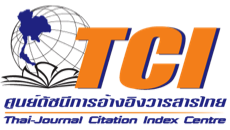การจัดการเรียนรู้เชิงรุกเพื่อส่งเสริมความสามารถในการแก้ปัญหาและการให้เหตุผลทางคณิตศาสตร์ของนักเรียนชั้นมัธยมศึกษาปีที่ 4 (Provision of Active Learning for Promoting Mathematical Problem Solving and Reasoning Abilities of Grade 10 Students)
คำสำคัญ:
การจัดการเรียนรู้เชิงรุก, ความสามารถในการแก้ปัญหาทางคณิตศาสตร์, ความสามารถในการให้เหตุผลทางคณิตศาสตร์บทคัดย่อ
การวิจัยเชิงปฏิบัติการในชั้นเรียนครั้งนี้มีวัตถุประสงค์ เพื่อศึกษา (1) ความสามารถในการแก้ปัญหาทางคณิตศาสตร์ และ (2) ความสามารถในการให้เหตุผลทางคณิตศาสตร์ของนักเรียนชั้นมัธยมศึกษาปีที่ 4 โดยการจัดการเรียนรู้เชิงรุก กลุ่มเป้าหมายคือนักเรียนชั้นมัธยมศึกษาปีที่ 4/2 ภาคเรียนที่ 2 ปีการศึกษา 2562 จำนวน 44 คน โรงเรียนยุพราชวิทยาลัย จังหวัดเชียงใหม่ เครื่องมือที่ใช้ในการวิจัยได้แก่ (1) แผนการจัดการเรียนรู้เชิงรุก เรื่อง กำหนดการเชิงเส้น จำนวน 6 แผน แบ่งออกเป็น 4 ขั้นตอน 1) เตรียมความพร้อม 2) ปฏิบัติกิจกรรม 3) สะท้อนคิด อภิปราย และสรุปผล 4) ประยุกต์ใช้ (2) แบบวัดความสามารถในการแก้ปัญหาทางคณิตศาสตร์ (3) แบบวัดความสามารถในการให้เหตุผลทางคณิตศาสตร์ ผลวิจัยพบว่า นักเรียนมีความสามารถในการแก้ปัญหาทางคณิตศาสตร์ทั้ง 4 ด้านในระดับดีมากและดี โดยเรียงลำดับร้อยละของคะแนนเฉลี่ยจากมากไปน้อยได้ ดังนี้ การทำความเข้าใจปัญหาหรือวิเคราะห์ปัญหา ร้อยละ 87.50 การวางแผนแก้ปัญหา ร้อยละ 79.55 การดำเนินการแก้ปัญหาและหาคำตอบ ร้อยละ 53.41 และการตรวจสอบคำตอบ ร้อยละ 51.14 มีร้อยละของคะแนนเฉลี่ยของความสามารถในการให้เหตุผลทางคณิตศาสตร์อยู่ในระดับดีมากและดี ตามลำดับ การวิเคราะห์หาความสัมพันธ์ของข้อมูล ร้อยละ 88.64 และการแสดงข้อสรุปของข้อมูล ร้อยละ 81.82
เอกสารอ้างอิง
Institute for the Promotion of Teaching Science and Technology (IPST). (2008). The Basic Education Core Curriculum B.E. 2551 (A.D. 2008) Mathematics. Bangkok: Religion Printing (in Thai).
Jannoom, T. (2015). Effects of Organizing Learning Activities Using Realistic Mathematics Education Approach and Advancing Children’s Thinking on Mathematical Reasoning and Communication Abilities of Eighth Grade Students. Master of Education Program in Mathematics Education Graduate Chulalongkorn University. (in Thai)
Ketthong, T. (2008). Effects of Organizing Learning Activities by Using Mathematical Modeling Process on Problem Solving Ability and Reasoning in Mathematics of Ninth Grade Students in School Under the Office of the Basic Education Commission in Lopburi. Master of Education Program in Mathematics Education Graduate Chulalongkorn University. (in Thai)
Khatsitalee, Y. (2014). Learning Provision with KWDL Technique to Prompte Mathematical Problem-solving and Reasoning Skills for Mattayom Suksa 3 Students, Baanpong School, Chiang Mai Province. Master of Education Program in Mathematics Education Graduate Chiang Mai University. (in Thai)
Krulik, S., Rudnick and J. A. (1993). Reasoning and problem solving: A handbook for elementary school teachers. Boston: Allyn and Bacon.
Makanong, A. (2011). The mathematical Skill and Process: The Develop to Development. Bangkok: Chulalongkorn University. (in Thai)
Nupad, K. (2016). A Development of Mathematical Problem - Solving Ability on Exponential and Logarithm Function by Reciprocal Teaching and Problem - Solving Strategies for Matayomsuksa 5 Students. Master of Education Program in Mathematics Education Graduate Burapha University. (in Thai)
Pakdeeviroch, C. (2013). The Effects of Organizing Active Learning in Mathematical Process Skills on Mathematical Problem Solving Ability, Critical Thinking Ability and Self-Confidence of Mathayomsuksa III Students. Master of Education Program in Secondary Education Graduate Srinakharinwirot University. (in Thai)
Panich, V. (2012). Ways to create learning for students. [Online]. Retrieved March 20, 2020, from
http://www.kruchiangrai.net/wp-content/uploads/2015/05/learn_c21.pdf.
Phattarakorn, S. (2009). The Effects of Organizing Active Learning on Problem Solving and Mathematical Communication Abilities of of Mathayomsuksa III Students in Probability. Master of Education Degree in Secondary Education At Srinakharinwirot University. (in Thai)
Promrak, M. (2013). Effects of Organizing Mathematics Learning Activities Using the Problem Solving Model of Metacognitive Process on Mathematics Problem Solving and Critical Thinking Abilities of Eighth Grade Students. Master of Education Program in Mathematics Education Graduate Chulalongkorn University. (in Thai)
Sema, P. (2016). Effects of Organizing Mathematics Learning Activities Using Inquiry Co-Operation Model on Mathematical Reasoning and Communication Abilities of Eighth Grade Students. Master of Education Program in Mathematics Education Graduate Chulalongkorn University. (in Thai)
Suwannatthachote, P. (2008). Active Learning. Bangkok: Chulalongkorn University. (in Thai)
The Secondary Educational Service Area Office 35. (2019). Active Learning. [Online]. Retrieved May 6, 2020, from http://www.secondary35.go.th/wp-content/uploads/2019/12/book10-62.pdf
Thongnuan, P. (2011). The Effects of Organizing Active Learning Emphasized Representation on Mathematical Achievement, Reasoning, and Communication Abilities in Relations and Functions of Mathayomsuksa IV Students. Master of Education Degree in Secondary Education At Srinakharinwirot University. (in Thai)
Wangwech, P. (2016). Effects of Organizing Mathematics Learning Activities Using the Problem Solving Model of Metacognitive Process with Four Corners and a Diamond Graphic Organizers on Mathematical Reasoning and Communication Abilities of Eighth Grade Students. Master of Education Program in Mathematics Education Graduate Chulalongkorn University. (in Thai)
Wiboonsin, K. (2017). “Effects of Organizing Mathematics Learning Activities Using the Flipped Classroom Approach and Active Learning on Mathematical Problem Solving Critical Thinking Abilities of Eleventh Grade Students”. OJED 2(3): 346 – 362. (in Thai)
Wongsakundee, S. (2015). “The Effects of Active Learning Activities on Mathematical Problem Solving and Reasoning Ability in Statistics of Mathayomsuksa 3 Students”. Veridian E-Journal, Silpakorn University 8(2):1265-1281. [Online]. Retrieved October 2, 2019, from https://he02.tci-thaijo.org/index.php/Veridian-E-Journal/article/view/40314/33265





